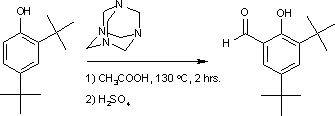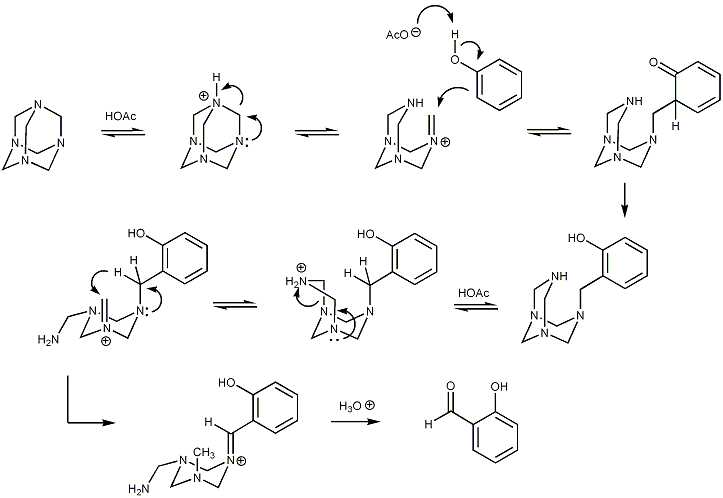Duff reaction
The Duff reaction or hexamine aromatic formylation is a formylation reaction used in organic chemistry for the synthesis of benzaldehydes with hexamine as the formyl carbon source.[1][2][3][4][5][6] It is named after James Cooper Duff, who was a chemist at the College of Technology, Birmingham, around 1920–1950.
The electrophilic species in this electrophilic aromatic substitution reaction is the iminium ion CH2+NR2. The initial reaction product is an iminium which is hydrolyzed to the aldehyde. See mechanism below. The reaction requires strongly electron donating substituents on the aromatic ring such as in a phenol. Formylation occurs ortho to the electron donating substituent preferentially, unless the ortho positions are blocked, in which case the formylation occurs para.[7]
Examples are the synthesis of 3,5-di-tert-butylsalicylaldehyde:[8]

and the synthesis of syringaldehyde:[9]

Reaction mechanism
The reaction mechanism displayed below [10] demonstrates step by step how hexamine donates a methine group to an aromatic substrate via a series of equilibria reactions, with iminium ion intermediates. Initially, addition to the aromatic ring results in an intermediate at the oxidation state of a benzylamine. An intramolecular redox reaction then ensues, raising the benzylic carbon to the oxidation state of an aldehyde. The oxygen atom is provided by water on acid hydrolysis in the final step.

See also
- Bouveault aldehyde synthesis
- Bodroux-Chichibabin aldehyde synthesis
- Reimer-Tiemann reaction
- Sommelet reaction
- Vilsmeier-Haack reaction
References
- Duff, J. C.; Bills, E. J. (1932). "273. Reactions between hexamethylenetetramine and phenolic compounds. Part I. A new method for the preparation of 3- and 5-aldehydosalicylic acids". J. Chem. Soc.: 1987. doi:10.1039/jr9320001987.
- Duff, J. C.; Bills, E. J. (1934). "282. Reactions between hexamethylenetetramine and phenolic compounds. Part II. Formation of phenolic aldehydes. Distinctive behaviour of p-nitrophenol". J. Chem. Soc.: 1305. doi:10.1039/jr9340001305.
- Duff, J. C.; Bills, E. J. (1941). "96. A new general method for the preparation of o-hydroxyaldehydes from phenols and hexamethylenetetramine". J. Chem. Soc.: 547. doi:10.1039/jr9410000547.
- Duff, J. C.; Bills, E. J. (1945). "71. A new method for the preparation of p-dialkylaminobenzaldehydes". J. Chem. Soc.: 276. doi:10.1039/jr9450000276.
- Lloyd Noel Ferguson (1946). "The Synthesis of Aromatic Aldehydes". Chem. Rev. 38 (2): 227–254. doi:10.1021/cr60120a002. PMID 21024865.
- Ogata, Y.; Sugiura, F. (1968). "Kinetics and mechanism of the Duff reaction". Tetrahedron. 24 (14): 5001. doi:10.1016/S0040-4020(01)88408-8.
- Mundy, Bradford P.; Ellerd, Michael G.; Favaloro, Frank G. (2005). Name Reactions and Reagents in Organic Synthesis, 2nd Edition, John Wiley & Sons, pp. 222 – 223.
- Larrow, Jay F.; Jacobsen, Eric N. (1998). "(R,R)-N,N'-Bis(3,5-di-tert-butylsalicylaldehyde)-1,2-cyclohexanediamino Manganese(III) Chloride, a Highly Enantioselective Epoxidation Catalyst". Organic Syntheses. 75: 1. doi:10.15227/orgsyn.075.0001.; Collective Volume, 10, p. 96
- Allen, C. F. H.; Leubner, Gerhard W. (1951). "Syringic aldehyde". Organic Syntheses. 31: 92. doi:10.15227/orgsyn.031.0092.; Collective Volume, 4, p. 866
- March, Jerry (1985), Advanced Organic Chemistry: Reactions, Mechanisms, and Structure (3rd ed.), New York: Wiley, ISBN 0-471-85472-7